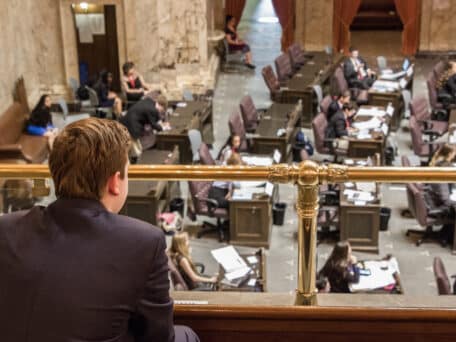On Thursday, the Sound Transit Board approved a motion to begin charging a fare on Tacoma Link light rail. Unfortunately for Puget Sound taxpayers, the tragicomic circumstances surrounding this action are all-too-common occurrences for Sound Transit’s labyrinthine bureaucracy.
The story begins with a 1999 analysis by Sound Transit that concluded, “fare collection costs would exceed the revenues to be gained from charging fares.” Because Sound Transit thought it would lose money by charging its customers, Tacoma Link has always been free to ride.
It should be noted that Tacoma Link isn’t the NYC Subway or the DC Metro, with a multitude of intersecting “lines” and scores of stations around the city. No, Tacoma Link, for those unfamiliar, is a 1.6-mile, 6-stop jaunt through Downtown Tacoma. It is almost a straight line. Yet somehow charging a fare, on the simplest rail route imaginable, would be a losing proposition.
And keep in mind that the cost analysis was only for the operating costs associated with collecting a fare—things like electricity powering ticket machines and paper to print tickets on. Capital costs, for buying the fare vending machine themselves, would be extra.
Rail transit is usually opposed on the grounds that it is too costly compared to roads or buses. In the case of Tacoma Link, there were so few riders that merely charging them a fare would lose money. Yet even though Sound Transit knew the mere act of charging a fare would be too expensive, it still elected to build a system where annual operating costs were 7.5 times higher and capital costs were 150 times higher than fare collection costs.
Thankfully, Sound Transit recently revisited the data and came to the realization that it would no longer lose money by charging riders. On Thursday, the Board was asked to decide what fare to charge. It was presented with ridership and revenue projections for potential fares ranging between $1 and $2. (For comparison purposes, Sound Transit reports the cost per boarding of Tacoma Link light rail, excluding capital costs and depreciation, is about $4.)
The $2.00 fare made a lot of sense:
- A $2 fare would generate the highest gross revenue and net revenue of the options studied.
- Net revenue of a $2 fare would enable the capital cost of fare collection equipment to be repaid in just 1.1 years.
- Pierce Transit also charges a $2 fare for its bus service (which is far cheaper to operate).
- Walking from terminus to terminus of Tacoma Link takes 35 minutes according to Google Maps, while riding it takes just 10 minutes. If you valued your time at minimum wage, walking has an opportunity cost of $3.83. So even with a $2 fare, the light rail would STILL be the cheapest option.
So what did the Board decide to do? It set the fare at $1, which will only net the agency $29,000 a year. At that rate, it would take 18.9 years to repay the cost of fare collection equipment. And did I mention Sound Transit still won’t start charging anything until September 2014? The “silver lining” was that the Board also voted for the fare to be raised to $1.50 in 2016.
Why did the Board choose such a low fare structure? It wasn’t (or shouldn’t have been) out of concern for pricing low-income individuals out of the system. University of Washington Tacoma students can purchase an all-access transit pass for $15 per month. Children under 6 would remain free, youth would only pay 75 cents, and the senior and disabled rate would be just 50 cents. On top of that, free passes will be given to community organizations for distribution to their low-income constituencies.
In fact, the Board selected a low fare upon advice of Sound Transit staff, who reported that “[a]lthough a $2.00 base fare would provide higher revenue generation and better pricing consistency with connecting transit service, the $1.50 base fare alternative [ed.: remember the Board ultimately chose an even lower fare] is more responsive to public feedback requesting that fares be kept as low as possible.” Of course the public wants fares as low as possible! We also want $1.50 iPhones and Seahawks tickets, but successful companies are mysteriously reluctant to charge customers unsustainable, loss-inducing prices. Welcome to Sound Transit: where the preposterousness would be funny if it weren’t sadly true.



